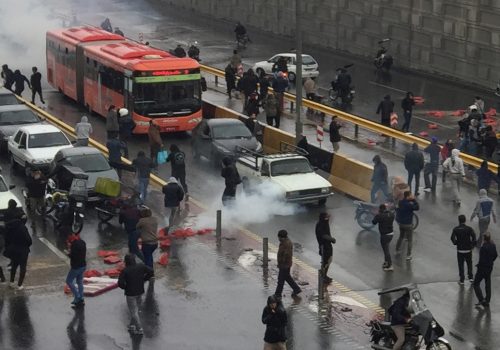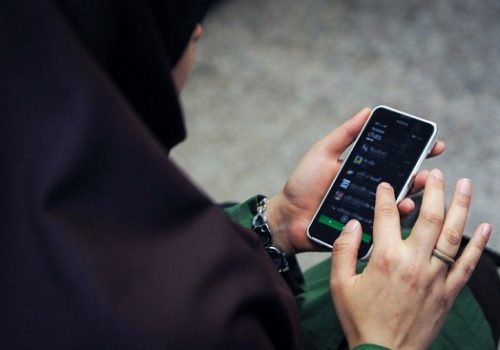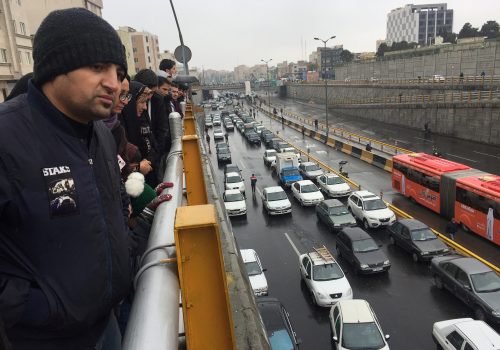Iranians endure internet shutdown with despair and disarray
On November 16, 2019, the Iranian government shut down the Internet throughout the country following a decision to triple the price of fuel overnight.
The abrupt price hike, coming at a time when Iranians are already dealing with 40 percent inflation in part because of US sanctions, plunged the country into upheaval as people took to streets and staged protests that turned bloody in some areas. Only after clashes began to wane did authorities give the green light for a “gradual” reestablishment of Internet connections on November 21. By Sunday, landline Internet connections were restored in most cities, but mobile data was still not working.
The five-day blackout surprised many Iranians and made them fearful that such an event could happen again. It derailed daily life, resulting in widespread disruptions in services including healthcare, financial transactions and even tests for admission to foreign universities.
A young artist who asked that his name not be used visited a drugstore near Haft-e-Tir Square on November 16 to fill a prescription for his sister. He told this reporter that the pharmacist said he couldn’t fill the prescription because “I can’t register your prescriptions on the insurer’s website. Come back later.” The young artist left the pharmacy in tears. He was eventually able to find the medication but had to pay extra.
A pharmacist in central Tehran told this reporter, “The Internet shutdown has disrupted the supply of medicine. There are many drugs that people cannot afford without their insurance.”
Other Iranians could not use insurance to pay for doctor visits.
The disrupted communications also caused severe anxiety among Iranians with relatives living abroad who normally use WhatsApp, Telegram, and Skype for daily chats with loved ones.
The fiancé of one young Iranian moved to the United States three months ago to continue her education. During the Internet blackout, they had to resort to landline telephones to check on each other.
The former head of Iran’s Chamber of Commerce, Mohessen Jalalpour, estimates that the blackout cost the Iranian economy $1.5 billion.
“Costs aside, I didn’t feel safe talking on the phone anymore,” the young Iranian said in an interview. “WhatsApp calls are end-to-end encrypted. It provided us with a sense of privacy. That’s not the case with phone calls.”
There are no official statistics on the number of Iranians living outside the Islamic Republic’s borders but they are believed to number at least seven million. Many in the diaspora took to social media to urge the Iranian government to restore the Internet, using hashtags such as #Internet4Iran that vent viral.
Hardliner politicians who have long opposed perceived foreign influence in Iran urged the government to keep the ban in place. They are demanding launch of a so-called “national internet,” a concept that has been ridiculed by Communications Minister Mohammad Javad Azari Jahromi.
“There is no such thing as ‘national internet’; this concept is a caricature,” Jahromi told the Iranian parliament’s news outlet. “This is not disruption. The Internet has been cut off and the Supreme National Security Council has ordered it.”
During the blackout, the Communications Ministry implemented measures to preserve a semblance of stability. Ride-hailing and domestic messaging apps were among services restored. The ministry also provided local news outlets with intermittent access to the Internet.
Homegrown messaging apps were working, but many Iranians shunned them. Most are not open source and are controlled by state agencies or semi-state owned companies.
Among the casualties of the blackout, according to Jahromi, were small and medium sized enterprises and startups. Jahromi told the state news agency IRNA on November 19that these companies were able to start offering services again using Iran’s National Information Network (NIN), an intranet that operates independently from the Internet.
“If it was not for the National Information Network, 2.5 million people employed by online mobility service providers would have joined the protesters in the streets,” Jahromi told IRNA.
However, the NIN is not a substitute for the World Wide Web. The Tehran newspaper Hamshahri reported that many small firms would have been pushed into bankruptcy if normal communication services had not been restored.
Nazanin Daneshvar, CEO of the website Takhfifan told Hamshahri, “We have lost 80 percent of our sales… [If the internet connection is not restored] we’ll be forced to close down our business.”
In addition to startups, industries that rely on foreign partners and suppliers were hit hard by the Internet outage. An Iranian woman who works for a local automotive company and asked that her name not be used, said in an interview: “We used to chat with our Chinese partners constantly via WeChat [a Chinese messaging app]. Our engineers rely on their Chinese counterparts’ counsel. Being cut off from the Internet, our operations have been disrupted.”
The former head of Iran’s Chamber of Commerce, Mohessen Jalalpour, estimates that the blackout cost the Iranian economy $1.5 billion. He told Khabaronline: “The internet shutdown cut us off from communicating with our foreign partners. We simply were not able to answer emails. Using telephone services and fax for business communications has become a thing of the past.”
Netblocks.org reported that the Internet shutdown cost Iran $369.5 million a day or $15.4 million per hour.
The decision to interrupt Internet connectivity was an especially big blow to a population that is among the world’s most dedicated Internet users. According to Iran’s Communications Regulatory Authority, 71 million Internet subscriptions have been registered in a country of 83 million people – a rate of 85.7 percent Internet penetration nationwide. The global average is about 67 percent.
A joint report from Hootsuite and We Are Social entitled “Global Digital 2019put the number of Iranian social media users at 47 million, or 57 percent of the population. That is not far behind the 70 percent rate in the United States.
The most popular social media platform in Iran was Telegram with 40 million users before it was banned in April 2018. Instagram hit 24 million active users in the same period, making Iran the seventh biggest market for the photo-sharing app.
One avid Instagram user told this reporter, “With the Internet cut off, I have got too much spare time on my hands. I would normally check my Instagram feed or chat with friends online. I don’t know what to do in my free time.”
During the blackout, people also could not access navigation apps such as Google Maps and Waze, as well as social media platforms and news websites.
One of those interviewed told this reporter that the worst was the inability to access Google as well as streaming services. Iranian millennials, just like their peers abroad, have stopped storing information on their handsets and computers. “I used to listen to my favorite songs on SoundCloud and Spotify,” said the young woman, who asked to remain anonymous. “Now I am going through my computer’s hard drive to find something to listen to.”
Many Iranians rely on cloud services for storing data or sharing it with friends. “Thanks to the Internet blockade, we are back to using flash drives,” she said.
The blackout also disrupted collaboration among Iranian scientists and foreign peers using Gmail and Skype. Furthermore, every year, thousands of Iranian students apply for masters and Ph.D. programs in Western universities, including the US. A main requirement is proof of language proficiency.
When one young scholar showed up during the blackout for an English exam, he was told that the test had been canceled. “I don’t know what to do,” he said. “Most application deadlines are fast approaching. If you have ever gone through the application process, you would know how awfully stressful it is. The government’s decision to pull the plug on connectivity for all has added a cherry on the top.”
In solidarity with their countrymen, Iranian students in the US and European countries started petitioning university admission offices to extend application deadlines for people living in Iran. Several institutions heeded the call and extended their deadlines.
Khosro Sayeh Isfahani is a Tehran-based
journalist.
Related Content
Image: EDITORS' NOTE: Reuters and other foreign media are subject to Iranian restrictions on leaving the office to report, film or take pictures in Tehran. A mother watches her daughter, who is in class at Pishtaz School, from home via the internet, in Tehran October 19, 2011. Pishtaz, the first computerised pre-school for gifted students in Iran, claims to have pioneered teaching techniques through the means of IT. Parents can watch their children's daily activities from home via CCTV cameras installed throughout the public areas in the school, which includes the classrooms, playgrounds and hallways. Picture taken October 19, 2011. REUTERS/Raheb Homavandi (IRAN - Tags: SOCIETY EDUCATION SCIENCE TECHNOLOGY)


